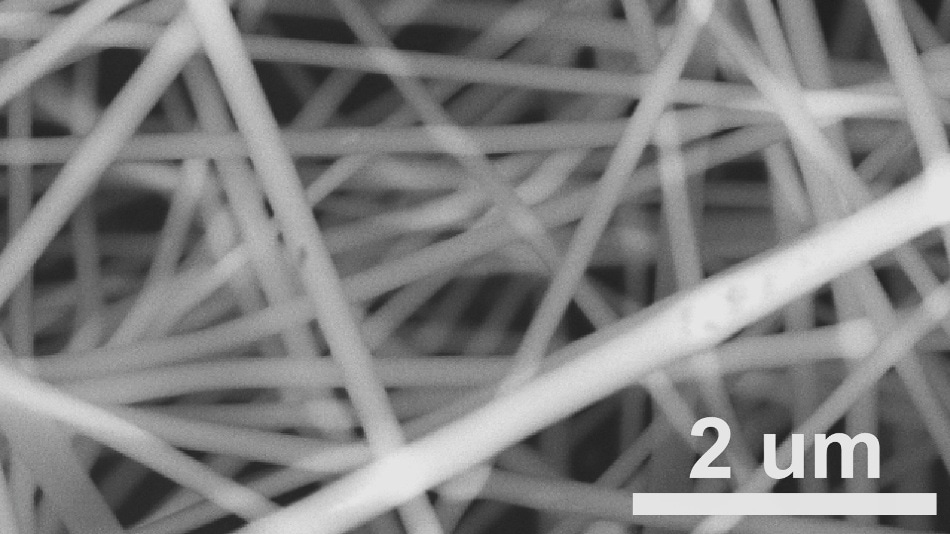May 29 2019
Electrospinning is a nanofiber fabrication method that is capable of producing micrometer- to nanometer-diameter metallic, ceramic, and polymer fibers of numerous compositions for a broad spectrum of applications, such as lithium batteries, tissue engineering, fuel cells, and filtration.
 Electrospun fibers have a high surface-area-to-volume ratio, which favors surface reaction applications like catalysts, and superior mechanical properties compared with their bulk counterparts, making them less subject to mechanical failure. (Image credit: Argonne National Laboratory)
Electrospun fibers have a high surface-area-to-volume ratio, which favors surface reaction applications like catalysts, and superior mechanical properties compared with their bulk counterparts, making them less subject to mechanical failure. (Image credit: Argonne National Laboratory)
Such materials possess special characteristics due to their large surface area and high-aspect-ratio morphology. However, the development of these materials has mostly been by trial and error methods, and hence, it is rather difficult to reproduce them reliably in industrial settings. This difficulty is attributed to the dearth of understanding of the fundamental dynamics during the process, in which over 10 control parameters are involved.
The measurements provide, for the first time, a systematic understanding of the spinning and annealing processes to control and enhance product performance.
Yuepeng Zhang, Materials Scientist, Argonne National Laboratory
Now, Argonne National Laboratory of the U.S. Department of Energy (DOE) is taking the uncertainty out of electrospinning by exploiting its special suite of capabilities to construct a database that correlates the parameters of electrospinning machine with nanofiber characteristics. With this suite of capabilities, companies will be able to design materials that are improved for certain applications at extreme speed and, at the same time, they can make potential real-time control and feedback on the manufacturing floor.
The state-of-the-art electrospinning center is part of the sophisticated manufacturing science and engineering effort of Argonne National Laboratory to speed up materials development as well as manufacturing processes by creating platform technologies improved with next-generation diagnostics and computing systems. A combination like this allows predictive science that lowers expensive trial-and-error prototyping. The manufacturing Laboratory-Directed Research and Development (LDRD) program of Argonne National Laboratory is funding the project.
Argonne National Laboratory is in an enviable position to develop electrospinning technology, thanks to a combination of know-how in the development and scaleup of materials, together with the special diagnostic capabilities available at the Advanced Photon Source (APS), APS is a DOE Office of Science User Facility and known as the highest-energy synchrotron X-ray source in the nation.
Headed by Argonne materials scientist Yuepeng Zhang, the team is carrying out in-situ X-ray measurements at the 12 ID-B beamline at the APS. These measurements are able to capture real-time chemical, physical and structural data from nanofibers as they develop and change at the time of processing, thus enabling correlation with processing parameters (for example, precursor viscosity, working distance, and voltage).
The measurements provide—for the first time—a systematic understanding of the spinning and annealing processes to control and enhance product performance.
Yuepeng Zhang, Materials Scientist, Argonne National Laboratory
The subsequent step is to feed the X-ray data into special machine-learning algorithms that operate on high-performance and advanced computing facilities at Argonne National Laboratory. These calculations will additionally reduce material defects, improve speed, remove expensive trial-and-error prototyping, and predict innovative properties.
In addition, the electrospinning capability can be modified for use with roll-to-roll manufacturing processes (in which continuous processing of a flexible substrate is done as it is moved between a pair of moving material rolls) to speed up commercialization and lower costs. Argonne National Laboratory is showing the roll-to-roll concept and its initial application by creating large-area LLZO solid-state electrolytes for use in energy storage.
Industries can partner with Argonne experts to devise electrospinning processes for their current materials, and they can also team up on novel or emerging (composite) designs and materials, including scaleup.